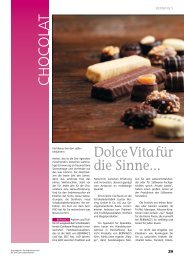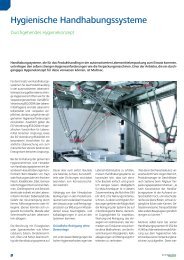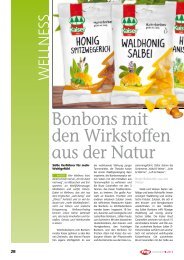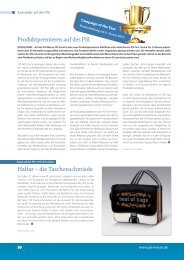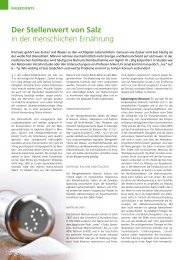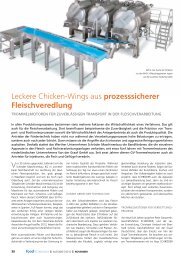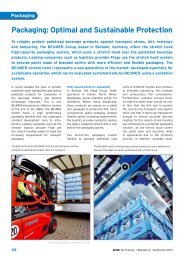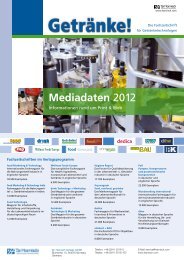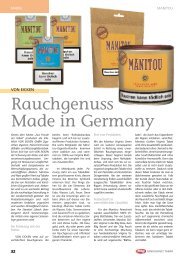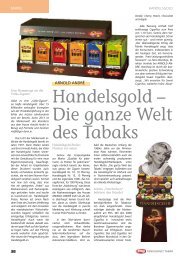Create successful ePaper yourself
Turn your PDF publications into a flip-book with our unique Google optimized e-Paper software.
Ingredients<br />
Syneresis %<br />
Control, Standard meat brine. 4,55<br />
Brine with 2% Ceamfibre 2,51<br />
Brine with 2% potato starch 2,91<br />
Table 3: Reduction of syneresis in pork ham<br />
with Ceamfibre 7000 compared to standard<br />
brine and to brine with potato starch added.<br />
quality comparable to traditional meat<br />
products without MDM added.<br />
Another important characteristic of citrus<br />
fibers is their capacity to maintain<br />
the original texture of the meat product<br />
once it has been heated. Since the fibers<br />
do not melt at high temperatures, they<br />
maintain their structure and their water<br />
retaining ability, which contributes to<br />
the improvement of the texture. (See<br />
Figure 3)<br />
Soy protein replacement<br />
Soy protein is used for emulsification<br />
and texturizing purposes. Soy isolates<br />
are mainly used to improve the texture<br />
of meat products, but are also used to<br />
increase protein content and to enhance<br />
moisture retention and emulsification.<br />
Nevertheless, soy protein can present<br />
some disadvantages that can be solved<br />
by substituting soy protein with citrus<br />
peel insoluble fibers. Some of these disadvantages<br />
when using soy protein are<br />
the lack of GMO free status (Genetically<br />
modified organisms) and the presence<br />
of allergens. Apart from the economic<br />
benefits when using citrus peel fibers,<br />
they provide a clean label and the warranty<br />
of a non-allergen origin.<br />
Replacement of starch with<br />
insoluble dietary citrus fiber<br />
Regarding the use of starch in meat<br />
products, insoluble dietary citrus fibers<br />
can eliminate some of the disadvantages<br />
of starch such as retrogradation<br />
(crystallization), undesirable viscosity<br />
creation and syneresis. In addition, the<br />
Ingredients %<br />
Oil 65,00<br />
Water 20,80<br />
Ceamfibre 7000SF 1.00<br />
Egg white 4,00<br />
Egg yolk 5,00<br />
Salt 1,00<br />
Sugar 0,50<br />
Potassium sorbate 0,20<br />
Vinegar 2,50<br />
TOTAL 100,00<br />
Table 4: Clean label mayonnaise with<br />
Ceamfibre 7000SF<br />
Photos & Tables: Ceamsa<br />
use of starch is limited in some countries<br />
due to their legislation. When the<br />
goal is to reduce syneresis, fibers thus<br />
can be a perfect substitute. (See Table 3)<br />
Insoluble dietary citrus fiber used in<br />
mayonnaise, ketchup and salsas<br />
Mayonnaise has demonstrated to be<br />
an interesting application for insoluble<br />
citrus peel fibers. The use of citrus<br />
fibers can lead to the total or partial<br />
substitution of expensive gums, such<br />
as xanthan and guar. Moreover, since<br />
fibers are an ingredient and not a food<br />
additive, we are able to obtain “clean<br />
label” products, fulfilling the needs of<br />
the most health-conscious consumers.<br />
(See Table 4 and 5)<br />
The use of fibers can also optimize the<br />
ingredient composition of a “light”<br />
product reducing significantly its fat<br />
content. This is interesting not only<br />
from a health point of view, but also<br />
from an economic stand point. When<br />
developing these challenging products,<br />
it is very important to maintain the<br />
organoleptic quality when a low fat<br />
containing product is compared to its<br />
high-fat counterpart. Insoluble citrus<br />
peel fiber, thanks to its water-binding<br />
capacity, increased viscosity and the<br />
neutral flavor, solves this important<br />
issue.<br />
Figure 5: Increased volume with Ceamfibre 7000F. Left: Cake with 4% Ceamfibre 7000F+ 4.4%<br />
water Middle: Cake with 4% Ceamfibre 7000F Right: Reference without Ceamfibre 7000F.<br />
Ingredients %<br />
Water 55,96<br />
Oil 23,62<br />
Vinegar 3,77<br />
Salt 3,31<br />
Sugar 5,68<br />
Egg 1,39<br />
Xanthan 0,3<br />
Guar 0,2<br />
Starch 3,77<br />
Ceamfibre 7000SF 2,00%<br />
Table 5: When applying Ceamfibre 7000SF in<br />
low fat mayonnaise the level of guar/xanthan<br />
can be reduced considerably.<br />
In the manufacture of ketchup and<br />
salsa, insoluble dietary citrus fibers can<br />
likewise substitute other gums or solids<br />
and support excellent eating quality.<br />
Applications in processed cheese<br />
Insoluble dietary citrus fibers also has<br />
a place in the cheese industry, where<br />
they will help to reduce syneresis and<br />
cost, by decreasing the amount of dry<br />
extract, or diminishing the use of more<br />
expensive gums, such as Locust bean<br />
gum. Equally important is the fact,<br />
that the fibers will provide a desired<br />
increased hot viscosity, which is important<br />
in the cheese process in terms<br />
of avoiding problems with splattering<br />
and work safety.<br />
Insoluble dietary citrus fiber used in<br />
bakery products<br />
During the past decades, the industry<br />
has mainly been focusing on a variety<br />
of bakery products, where almost<br />
exclusively refined flour was used,<br />
and from which the bran, germ and<br />
endosperm were stripped away. Nevertheless,<br />
a new trend has lately been<br />
developed, where both whole-grain<br />
products and fibers as ingredient are<br />
becoming increasingly demanded.<br />
In muffins and cake-type products fibers<br />
are added in order to acquire functional<br />
properties to improve texture,<br />
shrink control or volume. (See Figure 5)<br />
Due to the water binding capacity of<br />
the citrus peel fibers, they can replace<br />
up to 50% of the fat content without<br />
recognizing any change in the palatability,<br />
and, in some cases, they can<br />
even improve the moistness.<br />
food Marketing & Technology



